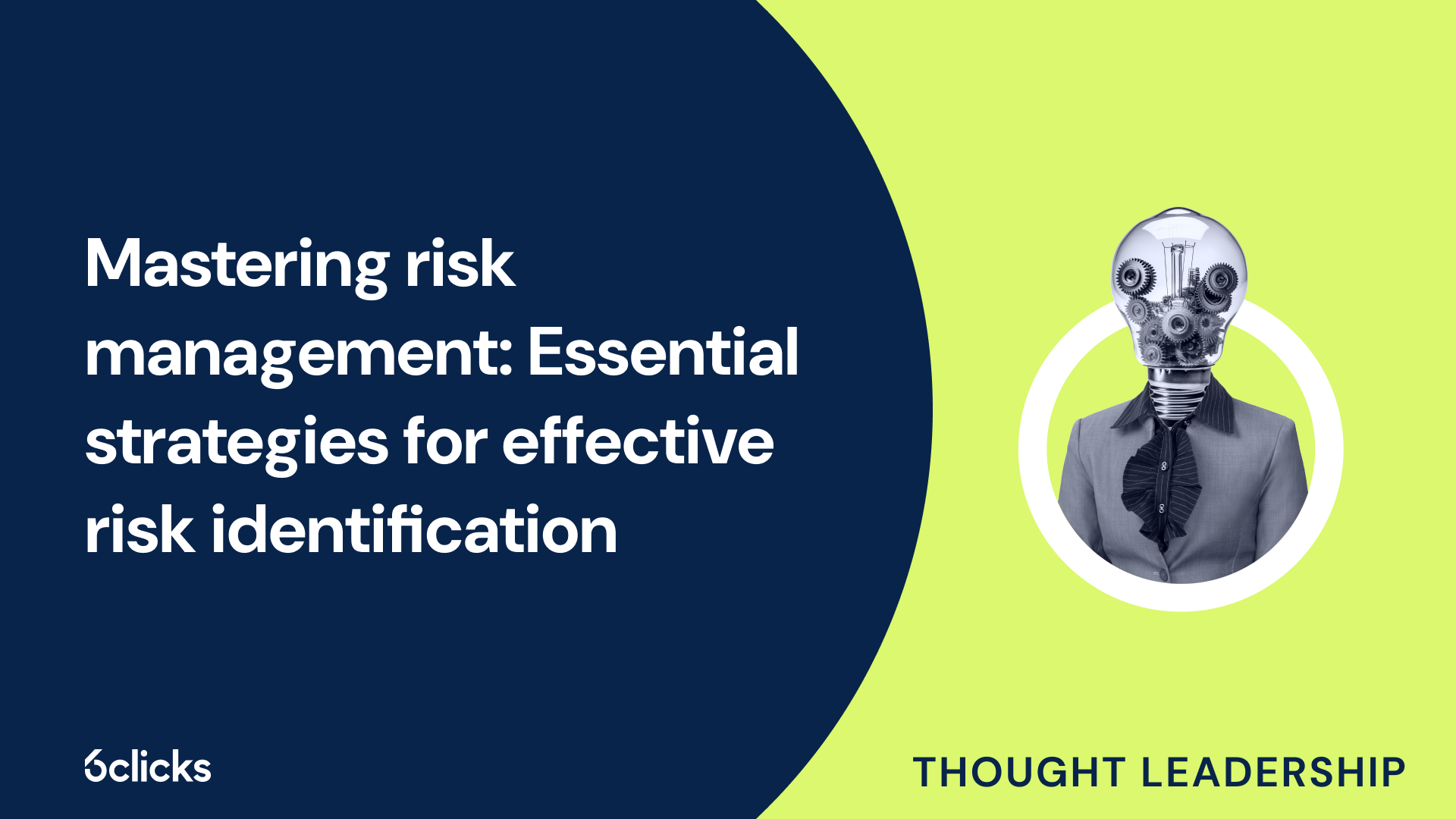
With today's advanced threat landscape, identifying risks early is more than just a compliance requirement. It's a crucial step in establishing a security culture built on resilience, agility, and operational efficiency. For CISOs, risk managers, and compliance professionals, mastering risk identification is a critical competency that directly influences business performance and strategic decision-making. Let's dive into the importance of early risk identification, advanced strategies and tools, how to build a robust risk management framework, and emerging trends shaping the future of enterprise risk management.
The importance of risk identification
Risk identification is the cornerstone of any risk management process. Without it, the ability to assess, mitigate, or monitor risk becomes impossible. Whether in cybersecurity, operational continuity, or strategic investments, early and accurate identification enables organizations to allocate resources effectively, respond proactively, and avoid downstream impacts.
Effective risk identification involves a structured process that enables organizations to proactively uncover and understand threats, which guides strategic decisions and creates the foundation for a risk-aware culture. It also helps:
-
Ensure alignment with internal policies and external regulatory requirements
-
Build trust with stakeholders, from board members to customers
-
Enable timely response to threats before they materialize or escalate
-
Support resource allocation by identifying priority areas of concern
-
Strengthen overall risk posture and operational readiness
Common types of risks in business
Understanding the types of risks that organizations face is essential to building a comprehensive identification process. Key categories include:

-
Strategic risks: Associated with high-level business decisions, such as mergers, market expansion, or innovation
-
Operational risks: Linked to internal processes, systems, and people—examples include supply chain disruptions and IT outages
-
Compliance risks: Stem from non-adherence to laws, regulations, and internal policies
-
Financial risks: Encompass market volatility, credit risks, and liquidity concerns
-
Cybersecurity risks: Include data breaches, ransomware, and third-party vulnerabilities
Increasingly, these categories overlap, making holistic identification and cross-functional collaboration even more important.
Key strategies for effective risk identification
Risk identification is not a one-time activity—it requires deliberate, continuous effort. The strategies outlined below help organizations elevate their approach, ensuring they remain vigilant, responsive, and resilient in the face of evolving threats.

Establish a formal risk taxonomy
A consistent language for risk classification ensures that all stakeholders understand and report risks similarly, supporting better aggregation and analysis. For example, organizations might define and differentiate between terms like "data breach," "data leak," and "unauthorized access" to avoid confusion and ensure accurate reporting. A mature taxonomy may also align risk categories with frameworks such as ISO/IEC 27001 or the NIST Cybersecurity Framework (CSF), providing a common structure that scales across departments and jurisdictions.
With 6clicks, you can implement a standardized risk taxonomy using a powerful risk register with customizable fields that support structured classification schemes. This enables teams to tag risks with consistent attributes such as category, department, and impact type to enhance filtering, reporting, and automation. Then, easily link risks to controls, compliance requirements, incident records, and other contextual data for a comprehensive and scalable risk strategy.
Leverage cross-functional expertise
Involving diverse teams—from IT and legal to HR and finance—captures a wider risk universe and uncovers hidden threats. Activities that foster this collaboration include joint risk identification workshops, regular interdepartmental risk roundtables, integrated audit and compliance planning sessions, and cross-functional tabletop exercises. Embedding risk liaisons within each business unit also helps surface localized issues and ensures risk insights flow both ways between central risk teams and operational units.
Conduct periodic workshops and risk reviews
Structured sessions with key stakeholders help surface emerging risks and validate existing assumptions. By revisiting and reassessing known risks to ensure they remain relevant, accurately evaluated, and effectively managed, organizations can maintain the integrity and reliability of their risk registers, ensuring decisions are based on up-to-date and contextually appropriate information.
Integrate third-party and external intelligence
Regulatory changes, geopolitical dynamics, and vendor-related issues must be factored into risk identification processes. Tracking regulatory updates and assessing supplier vulnerabilities are some of the ways organizations can proactively monitor external threats.
As an all-in-one platform for risk, compliance, and audit management, 6clicks’ Vendor Risk Management module equips organizations with complete functionality to streamline vendor onboarding, security reviews, and remediation. Easily customize onboarding forms, automate assessments, and link third parties to associated risks and treatment plans.

By integrating third-party data directly into your risk registers and enabling continuous monitoring of vendor performance and compliance status, you can detect emerging threats in your supply chain and third-party ecosystem before they escalate.
Reinforce the role of leadership in risk identification
Leadership plays a pivotal role in shaping how risk is identified, prioritized, and addressed across the organization. Their influence extends beyond strategy into setting expectations, allocating resources, and driving a culture of transparency and accountability. Leadership contributes in several critical ways:
-
Setting the tone at the top by promoting a proactive and risk-aware culture across all levels of the business
-
Allocating resources to support risk identification initiatives, such as technology platforms, staff training, and external intelligence services
-
Championing cross-functional collaboration by encouraging open communication and coordination across departments
-
Ensuring strategic alignment between identified risks and the organization’s goals, risk appetite, and regulatory obligations
When leadership is actively engaged in the risk identification process, it signals that risk management is a strategic priority; not just a compliance function.
Tools and techniques for risk assessment
Modern risk assessment brings together expert judgment with data-driven methodologies to provide a balanced and defensible view of organizational risk. This combination of qualitative insight and quantitative analysis helps organizations prioritize response strategies based on real-world impact and likelihood. Tools and techniques include:
-
Risk registers: Central repositories for tracking identified risks, ownership, impact, likelihood, and mitigation efforts. These help ensure accountability and provide a single source of truth for risk status and treatment progress. With 6clicks’ systematic risk registers, you can leverage custom fields and workflows, automatic risk scoring, and integrated task management features to centralize and streamline risk management activities.

-
Heat maps and risk matrices: Visual tools to prioritize and communicate risk severity and probability. They enable quick comprehension of risk exposure and help guide discussions with stakeholders on resource allocation. Built-in risk matrix reports and customizable dashboards from 6clicks provide boards and leadership with instant insights into their organization’s risk posture.

-
Scenario analysis: Modeling of hypothetical events and their potential impact on business functions. This allows organizations to stress-test their risk posture and prepare contingency plans for high-impact situations.
-
Control libraries and mapping tools: While not risk assessment tools per se, they help organizations understand control coverage, identify gaps across frameworks, and inform residual risk levels. These tools support more accurate, data-driven assessments and streamline audits through traceable mappings. 6clicks’ powerful AI engine, Hailey, automates the mapping of requirements between frameworks as well as the mapping of controls to frameworks, allowing teams to easily identify their level of compliance with new and existing requirements.

-
AI-driven assessments: Advanced platforms now analyze unstructured data such as assessment responses and automatically surface new risks or anomalies. 6clicks with Hailey AI, for example, can generate risks and issues directly from assessments and automatically categorize and link them to relevant data, such as associated vendors. This reduces manual effort and increases accuracy in risk detection.

Building a risk management framework
To scale risk identification and align it with broader enterprise risk management (ERM), organizations should build and continuously improve a formal risk management framework. Key components include:
-
Governance structures: Clear roles, responsibilities, and escalation paths for risk reporting.
-
Policy and procedure alignment: Standardized guidelines for how risks are identified, documented, assessed, and monitored.
-
Technology platforms: Centralized GRC platforms, such as 6clicks, enable automated workflows, real-time dashboards, and consistent documentation.
-
Continuous monitoring: Integrate real-time alerts, KPIs, and KRIs to surface risks as they evolve, not just during periodic reviews. 6clicks’ Continuous Control Monitoring capability enables organizations to detect issues and validate control effectiveness in real time.
This framework becomes even more critical for multi-entity businesses, where distributed operations and varying regulatory requirements add complexity.
Emerging trends in risk management
As organizations face a rapidly evolving threat landscape, risk identification strategies are advancing in several ways:
-
AI and machine learning: These technologies are enabling predictive insights by analyzing patterns across massive datasets, flagging emerging risks before they manifest. Tools like Hailey AI can now extract, interpret, and structure data from risks, issues, policies, and assessment responses, cutting down manual effort.
-
Integration with ESG and resilience: Modern programs are aligning risk with environmental, social, and governance (ESG) goals and resilience strategies.
-
Federated GRC models: Enterprises are adopting federated deployment models to allow business units to manage localized risks while maintaining centralized visibility and governance.
-
Risk quantification: Moving beyond qualitative heat maps to monetary impact modeling and scenario-based simulations for more precise, decision-grade insights. Models like FAIR (Factor Analysis of Information Risk) are increasingly used to calculate the financial value of risk scenarios, helping organizations prioritize investments in mitigation strategies based on potential loss exposure.
Together, these trends reflect a shift toward more proactive, data-driven, and integrated risk identification practices that better equip organizations to respond to uncertainty and complexity.
Conclusion
Mastering risk identification is not just about documenting what might go wrong. It’s about building a proactive, tech-enabled discipline that enhances agility and decision-making at every level of the organization. For CISOs, risk leaders, and compliance professionals, this means going beyond checklists and embracing AI, automation, and integrated governance to stay ahead.
As the complexity of risk grows, so must our methods of identifying and addressing it. The organizations that succeed will be those that combine structured frameworks with advanced technologies and empower their people to think forward, not just react.
Get started with 6clicks
Leverage smarter tools to transform your risk management processes and future-proof your business. With 6clicks, you can experience:
-
Integrated risk management, compliance, and audit readiness, where you can manage risks, vendors, controls, issues, incidents, and assessments in one place
-
Robust compliance management and risk mitigation, with built-in functionality for control implementation, task management, and automated control testing
-
Next-generation AI capabilities for risk and issue identification and remediation, accelerating and improving accuracy of results
-
AI-powered compliance with ISO 27001, NIST CSF, and other industry standards and regional regulations
-
Hub & Spoke architecture for centralized risk governance and multi-entity management with localized execution


